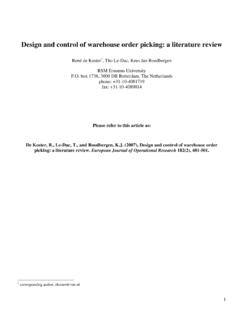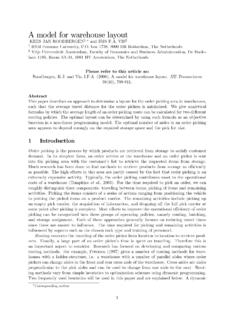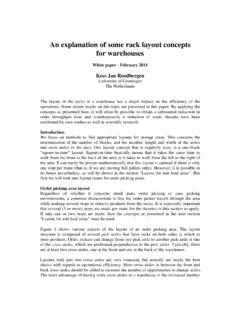Transcription of Routing methods for warehouses with multiple …
1 Routing methods for warehouseswith multiple cross aislesKees Jan Roodbergen and Ren de KosterErasmus University RotterdamRotterdam School of Management / Faculteit box 1738, 3000 DR Rotterdam, The NetherlandsPhone: +31-10-4088723, Fax: +31-10-4089014 Please refer to this article as:Roodbergen, and De Koster, R. (2001), Routing methods for warehouses with multiplecross Journal of Production Research39(9), paper considers Routing and layout issuesfor parallel aisle warehouses . In such ware-houses order pickers walk or drive along the aisles to pick products from storage. They canchange aisles at a number of cross aisles. These cross aisles are usually located at the front andback of the warehouse , but there can also be one or more cross aisles at positions in describe a number of heuristics to determine order picking routes in a warehouse with twoor more cross aisles.
2 To analyse the performance of the heuristics, a branch-and-bound algorithmis used that generates shortest order picking routes. Performance comparisons between heuristicsand the branch-and-bound algorithm are given for various warehouse layouts and order the majority of the instances with more than two cross aisles, a newly developed heuristicappears to perform better than the existing , some consequences for layout arediscussed. From the results it appears thatthe addition of cross aisles to the warehouse layout can decrease handling time of the ordersby lowering average travel times. However, adding a large number of cross aisles may increaseaverage travel times because the space occupied by the cross aisles has to be traversed as form an important link in the supply chain. Products can be stored temporarilyin warehouses and customer orders can befilled by retrieving products from storage.
3 However,warehousing generally requires a considerable amount of product handling, which is time con-suming. One way to decrease handling time is an entirely new design of the warehouse . Butoften it is also possible to decrease handling time by less radical methods such as changing theoperational order picking process is the process of retrieving products from specified storage locationson the basis of customer orders. The order picking process is in general one of the most timeconsuming processes in warehouses and contributes for a large extent to warehousing costs ( Tompkinset ). The productivity of the order picking process depends on factorssuch as the storage systems (racks), the layout and the control mechanisms. Order pickingproductivity can be improved by reducing handling time, reducing the time needed forpicking an order. This total picking time can be roughly divided in time for driving or walkingto locations (travel time), time for picking the products and time for remaining activities (such asobtaining a picklist and an empty pick carrier).
4 In warehouses with manual picking operations,travel time often forms the largest component of total picking time (Tompkinset ).1 Several methods can be used to reduce travel times by means of more efficient control mech-anisms. One approach is to determine good order picking routes. The problem of determiningorder picking routes consists offinding a sequence in which products have to be retrieved fromstorage such that travel distances are as short as possible. For a warehouse with two cross aisles,one at the front and one at the back, an efficient algorithm to determine shortest order pickingroutes has been developed by Ratliffand Rosenthal (1983). Heuristics for warehouses with twocross aisles can be found in Hall (1993). Performance comparisons between optimal Routing andheuristics for this type of warehouses are given in Petersen (1997) and De Koster and Van derPoort (1998).
5 Another method to reduce travel times is zoning, an order picker picks onlythat part of an order that is in his or her assigned zone. Also storage assignment rules canreduce travel times by assigning products to the right storage locations. For example, frequentlydemanded products can be located where they are easily accessible. Important in this respect isthe interaction between the Routing method and the storage assignment rule, see Petersenand Schmenner (1999). Finally, we can think of batching as a means of reducing travel is concerned with combining several (partial) orders in a single order picking batching strategies see Gibson and Sharp (1992), De Kosteret al.(1999) or Ruben andJacobs (1999).This paper will focus on Routing methods for warehouses with more than two cross preliminary study on heuristic Routing in this type of warehouses was done by Roodbergenand De Koster (1998).
6 They compare three heuristics for a number of situations, including anarrow- aisle high-bay warehouse where order picking trucks are used. A Routing heuristic, usingdynamic programming, for warehouses with morethan two cross aisles is presented by Vaughanand Petersen (1999).In this paper we will extend heuristics, that exist for warehouses with two cross aisles, sothey can be used in warehouses with more than two cross aisles. Furthermore, we will present anew Routing heuristic, called thecombined heuristic, and give some improvements for it, whichwill be tested under the namecombined+. Like the heuristic of Vaughan and Petersen (1999),the combined heuristic uses dynamic programming to determine order picking routes. The maindifference lies in the restrictions on the sequencingof the picks. The performance of all heuristicsis compared for the situation of a shelf area where order pickers walk through the warehouseto pick items, using a small pick cart.
7 A branch-and-bound procedure that generates shortestorder picking routes is used as a benchmark. It is shown that in most cases, the combined+heuristic has a better performance than the other 2 describes warehouse layout and Routing issues and extensions of some existingrouting methods . In section 3 the combined Routing heuristic is described to determine routesin a warehouse with two or more cross aisles. Section 4 compares the performance of all routingmethods. Section 5 contains warehouse layout and routingA graphical sketch of the warehouse layout considered in this paper is given infigure 1. Thewarehouse is rectangular with no unused space and consists of a number of parallelpick warehouse is divided into a number ofblocks,each of which contains a number of that part of a pick aisle that is within one block. The termaisleis used when astatement holds for both pick aisles and subaisles.
8 At the front and back of the warehouse andbetween each pair of blocks, there is across aisle . cross aisles do not contain storage locations,but can be used to change aisles. Every block has afront cross aisleand aback cross aisle ;thefront cross aisle of one block is the back cross aisle of another block, except for thefirst number of cross aisles equals the number of blocks plus one. This holds because there isone cross aisle in the front, one in the back and one between each two adjacent blocks.[Insertfigure 1 about here]Order pickers are assumed to be able to traverse the aisles in both directions and to beable to change direction within the aisles. The aisles are narrow enough to allow picking fromboth sides of the aisle without changing position. See Goetschalckx and Ratliff(1988) for issuesconcerning aisle width. Each order consists of a number of items that are usually spread out overa number of subaisles.
9 We assume that the items of an order can and will be picked in a singleroute. aisle changes are possible in any of the cross aisles. Picked orders have to be depositedat the depot, where the picker also receives the instructions for the next route. The depot islocated at the head of thefirst pick aisle in the front cross aisle . Note that the location of thedepot can potentially influence the average travel time. Petersen (1997) evaluated the effect ofdepot location forfive pick list sizes and four warehouse layouts. On average the difference inroute length between a depot located in the corner and a depot in the middle was less than 1%.In the remainder of this section we describe four different types of Routing . Two heuristicsare based on well known heuristics for a layout with two cross aisles: S-shape and largest , the Routing strategy of Vaughan and Petersen (1999) is described briefly.
10 Thefourth Routing method, consists offinding a shortest S-shapeBasically, any subaisle containing at least onepick location is traversed through the entirelength. Subaisles where nothing has to be picked are skipped. In the following more elaboratedescription of the heuristic, letters between brackets correspond to the letters in the exampleroute depicted infigure Determine the left most pick aisle that contains at least one pick location (calledleft pickaisle) and determine the block farthest from the depot that contains at least one picklocation (calledfarthest block).2. The route starts by going from the depot to the front of the left pick aisle (a).3. Traverse the left pick aisle up to the front cross aisle of the farthest block(b).4. Go to the right through the front cross aisle of the farthest block until a subaisle with apick is reached(c). If this is the only subaisle in this block with pick locations then pickall items and return to the front cross aisle of this block.








